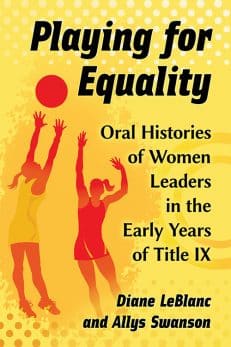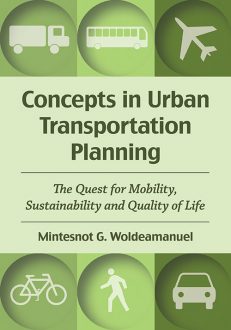Concepts in Urban Transportation Planning
The Quest for Mobility, Sustainability and Quality of Life
$29.95
In stock
About the Book
This book offers solutions for creating sustainable urban transportation. Topics include historical developments, planning, policy and legislative initiatives, nonmotorized and public transportation, environmental and social justice issues, and safety. The author discusses social, health and economic consequences of autocentric transportation and possible policy measures to address them. The important topic of changing travel behavior is discussed. Chapters contain straightforward concepts, case studies, review questions and ideas for class projects.
Instructors considering this book for use in a course may request an examination copy here.
About the Author(s)
Bibliographic Details
Mintesnot G. Woldeamanuel
Format: softcover (7 x 10)
Pages: 288
Bibliographic Info: 64 photos, glossary, bibliographies, index
Copyright Date: 2016
pISBN: 978-0-7864-9966-3
eISBN: 978-1-4766-2316-0
Imprint: McFarland
Table of Contents
Preface 1
Part I: History, Planning and Environmental Policy
1. Exploring Urban Transportation (Introduction 5; Historical Perspective 7; Social, Psychological and Cultural Perspectives 8; Environmental Perspective 12; Spatial and Geographical Perspective 14; Economic Perspective 15; Review Questions 18; Project/Paper Ideas 18; Videos • Internet Sources • Bibliography 19)
2. History of Urban Transportation: How Highways and Automobiles Shape American Cities (In the Beginning 20; The Advent of Motorization 21; U.S. Roads and Highway Systems 24; Getting into the Car Culture 27; The Need for Planning and Policy 30; Environmental Concerns 34; Recent, Future and New Technologies 36; Review Questions 39; Project/Paper Idea 39; Videos • Internet Sources • Bibliography 39)
3. Transportation Policy and the Planning Process (Introduction 41; The Transportation Planning Process 42; Transportation Plans 47; Actors in Transportation Planning 50; Transportation Policy Instruments 55; Review Questions 57; Project/Paper Idea 57; Internet Sources • Bibliography 57)
4. Travel Demand Forecasting: The Four-Step Model (Introduction 59; Prerequisites to the Four-Step Model 60; Step 1: Trip Generation 63; Step 2: Trip Distribution 67; Step 3: Modal Split 72; Step 4: Network Assignment 75; Class Exercise 77; Practice Problems 79; Bibliography 81)
5. Impacts of Transportation on the Environment and Society (Introduction 82; Auto Dependency and Its Impact 83; Possible Solutions 86; Travel Demand Management as Environmental Solution 87; Other Sustainable Solutions 95; Review Questions 100; Project/Paper Idea 101; Videos • Internet Sources • Bibliography 101
Part II: Planning for Drive-Alternative Means of Travel
6. Driving Less: Changing Travel Behavior (Introduction: Why Do We Need to Change Travel Behavior? 107; Change Means Avoiding Unnecessary Car Trips 113; Limiting Auto Use115; The Challenge: Convenience vs. Consciousness 119; Review Questions 121; Project/Paper Idea 121; Videos • Internet Sources • Bibliography 121)
7. Planning for Non-Motorized Transportation—Walking and Cycling (Introduction 124; The Benefit of Walking and Biking 126; The Built Environment and Walking or Biking 128; Sidewalk Infrastructure 131; Bicycling Infrastructure 134; Planning for Non-Motorized Transportation 140; Successful Bicycling Practices 141; Review Questions 145; Project/Paper Ideas 145; Videos • Internet Sources • Bibliography 146)
8. Planning for Public Transportation (Introduction 149; Public Transportation in American Cities 150; Health and Quality of Life Benefits 152; Environmental Benefits 154; Economic Benefit 155; Transit Oriented Developments 156; Why Public Transit Is Not Popular in the United States 159; Planning for Public Transportation 162; Review Questions 168; Project/Paper Idea 168; Videos • Internet Sources • Bibliography 168)
Part III: Planning for Safety and Social Equity
9. Traffic Accidents and Safety Issues (Introduction 173; History of Automobile Safety in the United States 175; Causes of Traffic Accidents 178; The Human Factor: Driver Behavior 179; Vehicle Mechanical Failure 183; Road Design and Environmental Factors 183; To Stop or Not to Stop: Safety at Intersections 185; Measures to Reduce Traffic Accidents 186; Effects 189; Lessons Learned 189; Review Questions 189; Project/Paper Idea 190; Videos • Internet Sources • Bibliography 190)
10. Social Equity and the Transportation-Disadvantaged (Introduction 192; Challenges of the Low-Income 193; Challenges of the Elderly 197; Challenges of the Disabled 200; Challenges of New Immigrants 201; Planning for the Disadvantaged 204; Review Questions 209; Project/Paper Idea 209; Videos • Internet Sources • Bibliography 209)
Part IV: Urban Transportation Outside the United States
11. Urban Transportation in Europe (Introduction 215; Transportation and the European Union 217; A Paradigm Shift in Car Ownership and Use: Germany 219; Sustainable Transportation in Europe 220; Special Features of European Transportation 226; Lessons Learned from European Transportation 228; Review Questions 230; Project/Paper Idea 231; Videos • Internet Sources • Bibliography 231
12. Urban Transportation in the Developing World (Introduction: Cities and Transportation in the Developed World 233; Bogotá’s TransMilenio 235; Curitiba’s BRT: A Model for the World 237; Transportation in Chinese Cities 240; Transportation in Africa 242; Conclusion 250; Review Questions 251; Project/Paper Idea 251; Videos • Internet Sources • Bibliography 251)
Glossary 255
Index 267





